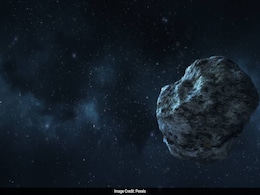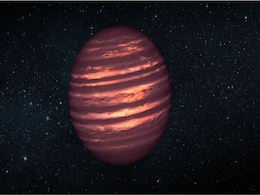Atmospheric Scientist
- All
- News
- Videos
-

Scientists Finally Identify What Drives Venus’s Fast Winds
- Saturday November 29, 2025
- Written by Gadgets 360 Staff
A new study has identified the primary force behind Venus’s extreme superrotating atmosphere: a once-per-day thermal tide driven by solar heating. Using data from Venus Express and Akatsuki along with circulation models, researchers show that this daily tide transports most of the momentum that accelerates cloud-top winds to speeds over 100 metre...
-
 www.gadgets360.com
www.gadgets360.com
-

'Mini-Lightning': NASA Rover Detects Electrical Discharges On Mars
- Thursday November 27, 2025
- World News | Reuters
NASA's Perseverance rover has obtained evidence that the atmosphere of Mars is electrically active, detecting electrical discharges - what one scientist called "mini-lightning" - often associated with whirlwinds called dust devils
-
 www.ndtv.com
www.ndtv.com
-

Antarctic Ozone Layer Shows Signs Of Recovery: NASA
- Tuesday November 25, 2025
- Science | Edited by NDTV News Desk
The Antarctic ozone layer is showing signs of recovery, reaching an annual maximum of 8.83 million square miles on September 9, scientists from NASA and the National Oceanic and Atmospheric Administration (NOAA) said.
-
 www.ndtv.com
www.ndtv.com
-

Scientists Create Earth's Most Accurate Digital Twin To Date, Could Revolutionise Climate Modelling
- Wednesday November 12, 2025
- Science | Edited by Ritu Singh
The model operates at a 1.25-kilometer resolution, a massive improvement over traditional models that typically have a 40-kilometer resolution.
-
 www.ndtv.com
www.ndtv.com
-

NASA’s ESCAPADE Mission Will Send Twin Probes to Uncover Mars’s Atmospheric Secrets
- Monday November 10, 2025
- Written by Gadgets 360 Staff
NASA’s ESCAPADE mission will launch twin mini-satellites, Blue and Gold, to Mars aboard Blue Origin’s New Glenn. The probes will study how solar wind stripped away Mars’s atmosphere and water, helping scientists understand the Red Planet’s lost climate and its transformation into the dry world we see today.
-
 www.gadgets360.com
www.gadgets360.com
-

Scientists Find Water And Oil Mixing On Saturn's Moon During Simulation, Defying Rules Of Chemistry
- Tuesday November 4, 2025
- Science | Edited by Srishti Singh Sisodia
Researchers simulated Titan's atmosphere and surface conditions in laboratory experiments.
-
 www.ndtv.com
www.ndtv.com
-

Can Amazon Rainforest Survive Future? Scientists Test It With 'Time Machine'
- Friday October 31, 2025
- World News | Reuters
Deep in Brazil's Amazon, scientists have built a "time machine" pumping carbon dioxide into the rainforest canopy to simulate atmospheric conditions predicted for the future to gauge how the biome adapts, an open question to be discussed at the COP30
-
 www.ndtv.com
www.ndtv.com
-

Scientists May Have Finally Solved the Sun’s Mysteriously Hot Atmosphere Puzzle
- Thursday October 30, 2025
- Written by Gadgets 360 Staff
Scientists using the Daniel K. Inouye Solar Telescope have detected Alfvén waves in the Sun’s corona, potentially solving the long-standing mystery of its extreme heat and helping refine models of solar and stellar energy transfer.
-
 www.gadgets360.com
www.gadgets360.com
-

NASA’s JWST Produces First-Ever 3D Map of Distant Planet WASP-18b
- Monday November 3, 2025
- Written by Gadgets 360 Staff
NASA’s James Webb Space Telescope has created the first-ever 3D atmospheric map of an exoplanet, revealing the extreme conditions on WASP-18b, an “ultra-hot Jupiter” located 400 light-years away. Using infrared eclipse mapping, scientists discovered a scorching hotspot over 2,700 °C where water molecules are breaking apart. This groundbreaki...
-
 www.gadgets360.com
www.gadgets360.com
-

Mysterious 1950s Sky Flashes Re-Examined in New Astronomical Study
- Tuesday November 4, 2025
- Written by Gadgets 360 Staff
Thousands of unexplained sky flashes captured in 1950s Palomar Observatory photos are being reanalysed. Scientists suspect they may have resulted from sunlight reflecting off early satellites or atmospheric changes after nuclear tests, which increased flash rates by up to 68%. Still, photographic artifacts remain a possible explanation.
-
 www.gadgets360.com
www.gadgets360.com
-

Scientists Detect Hidden Magnetic Waves That Could Explain the Sun’s Mysterious Heat
- Sunday November 2, 2025
- Written by Gadgets 360 Staff
For the first time, scientists have directly observed twisting Alfvén waves in the Sun’s corona using the Inouye Solar Telescope. The discovery could explain why the Sun’s outer atmosphere is millions of degrees hotter than its surface, offering key insights into solar energy transfer and space weather prediction.
-
 www.gadgets360.com
www.gadgets360.com
-

Scientists Find Rare Meteorites In China's Chang'e-6 Moon Samples
- Tuesday October 28, 2025
- Science | Edited by Astitva Raj
Chang'e 6 made history in 2024, by bringing back 1,935.3 grams of lunar samples from the Moon's South Pole-Aitken Basin.
-
 www.ndtv.com
www.ndtv.com
-

Atmospheric Carbon Dioxide Soars to 424PPM, Marking Biggest Yearly Jump Ever
- Friday October 17, 2025
- Written by Gadgets 360 Staff
The WMO reports Earth’s atmospheric CO₂ reached 422.8 ppm in 2024 — the biggest annual rise ever recorded. Driven by fossil-fuel emissions, wildfires, and weakening carbon sinks, the surge intensifies global warming. Scientists warn that delayed emission cuts could entrench irreversible changes in weather, ecosystems, and sea levels.
-
 www.gadgets360.com
www.gadgets360.com
-

James Webb Space Telescope Detects Phosphine on Brown Dwarf Wolf 1130C
- Thursday October 9, 2025
- Written by Gadgets 360 Staff
Using the James Webb Space Telescope, scientists have detected phosphine gas in the atmosphere of the brown dwarf Wolf 1130C, about 54 light-years away. The finding suggests phosphine can form in extreme, non-biological environments, challenging its status as a potential biomarker and reshaping how scientists search for alien life.
-
 www.gadgets360.com
www.gadgets360.com
-

Rubin Observatory Adopts New AI Algorithm to Enhance Cosmic Imaging
- Tuesday September 30, 2025
- Written by Gadgets 360 Staff
Scientists have developed ImageMM, an algorithm tested on Hawaii’s Subaru Telescope and soon to be used at the Rubin Observatory. The system reduces atmospheric blur, producing sharper images for studying galaxies and dark matter. Researchers believe the technique could make ground-based astronomy nearly as precise as space telescopes
-
 www.gadgets360.com
www.gadgets360.com
-

Scientists Finally Identify What Drives Venus’s Fast Winds
- Saturday November 29, 2025
- Written by Gadgets 360 Staff
A new study has identified the primary force behind Venus’s extreme superrotating atmosphere: a once-per-day thermal tide driven by solar heating. Using data from Venus Express and Akatsuki along with circulation models, researchers show that this daily tide transports most of the momentum that accelerates cloud-top winds to speeds over 100 metre...
-
 www.gadgets360.com
www.gadgets360.com
-

'Mini-Lightning': NASA Rover Detects Electrical Discharges On Mars
- Thursday November 27, 2025
- World News | Reuters
NASA's Perseverance rover has obtained evidence that the atmosphere of Mars is electrically active, detecting electrical discharges - what one scientist called "mini-lightning" - often associated with whirlwinds called dust devils
-
 www.ndtv.com
www.ndtv.com
-

Antarctic Ozone Layer Shows Signs Of Recovery: NASA
- Tuesday November 25, 2025
- Science | Edited by NDTV News Desk
The Antarctic ozone layer is showing signs of recovery, reaching an annual maximum of 8.83 million square miles on September 9, scientists from NASA and the National Oceanic and Atmospheric Administration (NOAA) said.
-
 www.ndtv.com
www.ndtv.com
-

Scientists Create Earth's Most Accurate Digital Twin To Date, Could Revolutionise Climate Modelling
- Wednesday November 12, 2025
- Science | Edited by Ritu Singh
The model operates at a 1.25-kilometer resolution, a massive improvement over traditional models that typically have a 40-kilometer resolution.
-
 www.ndtv.com
www.ndtv.com
-

NASA’s ESCAPADE Mission Will Send Twin Probes to Uncover Mars’s Atmospheric Secrets
- Monday November 10, 2025
- Written by Gadgets 360 Staff
NASA’s ESCAPADE mission will launch twin mini-satellites, Blue and Gold, to Mars aboard Blue Origin’s New Glenn. The probes will study how solar wind stripped away Mars’s atmosphere and water, helping scientists understand the Red Planet’s lost climate and its transformation into the dry world we see today.
-
 www.gadgets360.com
www.gadgets360.com
-

Scientists Find Water And Oil Mixing On Saturn's Moon During Simulation, Defying Rules Of Chemistry
- Tuesday November 4, 2025
- Science | Edited by Srishti Singh Sisodia
Researchers simulated Titan's atmosphere and surface conditions in laboratory experiments.
-
 www.ndtv.com
www.ndtv.com
-

Can Amazon Rainforest Survive Future? Scientists Test It With 'Time Machine'
- Friday October 31, 2025
- World News | Reuters
Deep in Brazil's Amazon, scientists have built a "time machine" pumping carbon dioxide into the rainforest canopy to simulate atmospheric conditions predicted for the future to gauge how the biome adapts, an open question to be discussed at the COP30
-
 www.ndtv.com
www.ndtv.com
-

Scientists May Have Finally Solved the Sun’s Mysteriously Hot Atmosphere Puzzle
- Thursday October 30, 2025
- Written by Gadgets 360 Staff
Scientists using the Daniel K. Inouye Solar Telescope have detected Alfvén waves in the Sun’s corona, potentially solving the long-standing mystery of its extreme heat and helping refine models of solar and stellar energy transfer.
-
 www.gadgets360.com
www.gadgets360.com
-

NASA’s JWST Produces First-Ever 3D Map of Distant Planet WASP-18b
- Monday November 3, 2025
- Written by Gadgets 360 Staff
NASA’s James Webb Space Telescope has created the first-ever 3D atmospheric map of an exoplanet, revealing the extreme conditions on WASP-18b, an “ultra-hot Jupiter” located 400 light-years away. Using infrared eclipse mapping, scientists discovered a scorching hotspot over 2,700 °C where water molecules are breaking apart. This groundbreaki...
-
 www.gadgets360.com
www.gadgets360.com
-

Mysterious 1950s Sky Flashes Re-Examined in New Astronomical Study
- Tuesday November 4, 2025
- Written by Gadgets 360 Staff
Thousands of unexplained sky flashes captured in 1950s Palomar Observatory photos are being reanalysed. Scientists suspect they may have resulted from sunlight reflecting off early satellites or atmospheric changes after nuclear tests, which increased flash rates by up to 68%. Still, photographic artifacts remain a possible explanation.
-
 www.gadgets360.com
www.gadgets360.com
-

Scientists Detect Hidden Magnetic Waves That Could Explain the Sun’s Mysterious Heat
- Sunday November 2, 2025
- Written by Gadgets 360 Staff
For the first time, scientists have directly observed twisting Alfvén waves in the Sun’s corona using the Inouye Solar Telescope. The discovery could explain why the Sun’s outer atmosphere is millions of degrees hotter than its surface, offering key insights into solar energy transfer and space weather prediction.
-
 www.gadgets360.com
www.gadgets360.com
-

Scientists Find Rare Meteorites In China's Chang'e-6 Moon Samples
- Tuesday October 28, 2025
- Science | Edited by Astitva Raj
Chang'e 6 made history in 2024, by bringing back 1,935.3 grams of lunar samples from the Moon's South Pole-Aitken Basin.
-
 www.ndtv.com
www.ndtv.com
-

Atmospheric Carbon Dioxide Soars to 424PPM, Marking Biggest Yearly Jump Ever
- Friday October 17, 2025
- Written by Gadgets 360 Staff
The WMO reports Earth’s atmospheric CO₂ reached 422.8 ppm in 2024 — the biggest annual rise ever recorded. Driven by fossil-fuel emissions, wildfires, and weakening carbon sinks, the surge intensifies global warming. Scientists warn that delayed emission cuts could entrench irreversible changes in weather, ecosystems, and sea levels.
-
 www.gadgets360.com
www.gadgets360.com
-

James Webb Space Telescope Detects Phosphine on Brown Dwarf Wolf 1130C
- Thursday October 9, 2025
- Written by Gadgets 360 Staff
Using the James Webb Space Telescope, scientists have detected phosphine gas in the atmosphere of the brown dwarf Wolf 1130C, about 54 light-years away. The finding suggests phosphine can form in extreme, non-biological environments, challenging its status as a potential biomarker and reshaping how scientists search for alien life.
-
 www.gadgets360.com
www.gadgets360.com
-

Rubin Observatory Adopts New AI Algorithm to Enhance Cosmic Imaging
- Tuesday September 30, 2025
- Written by Gadgets 360 Staff
Scientists have developed ImageMM, an algorithm tested on Hawaii’s Subaru Telescope and soon to be used at the Rubin Observatory. The system reduces atmospheric blur, producing sharper images for studying galaxies and dark matter. Researchers believe the technique could make ground-based astronomy nearly as precise as space telescopes
-
 www.gadgets360.com
www.gadgets360.com

















